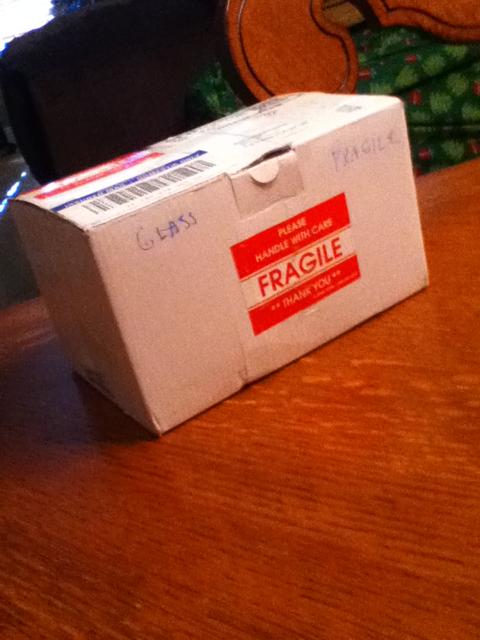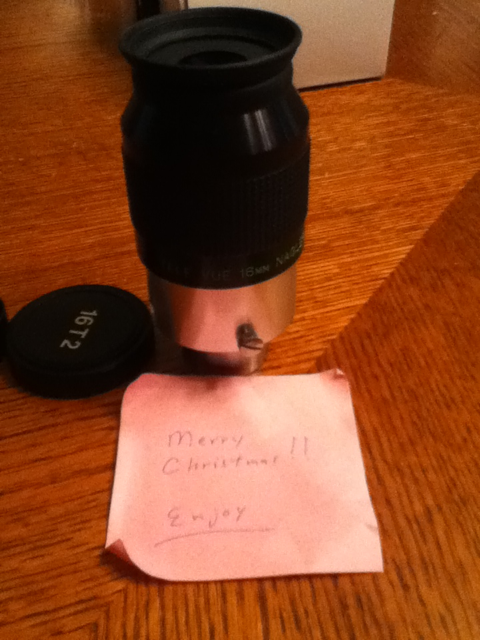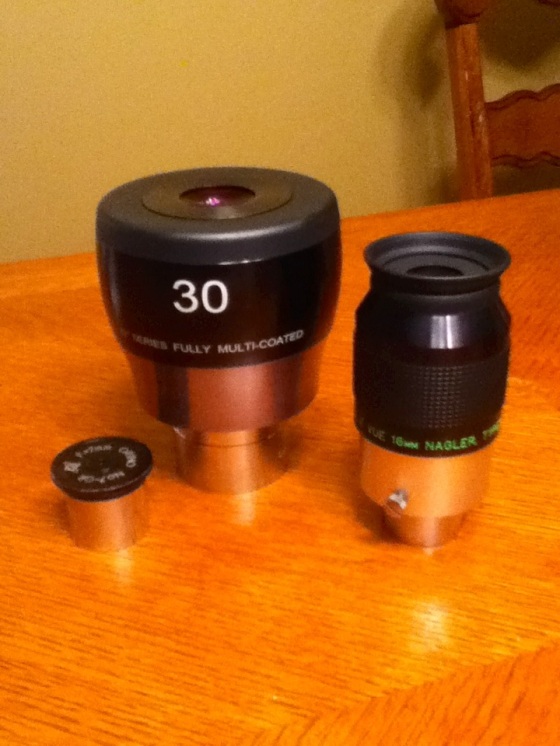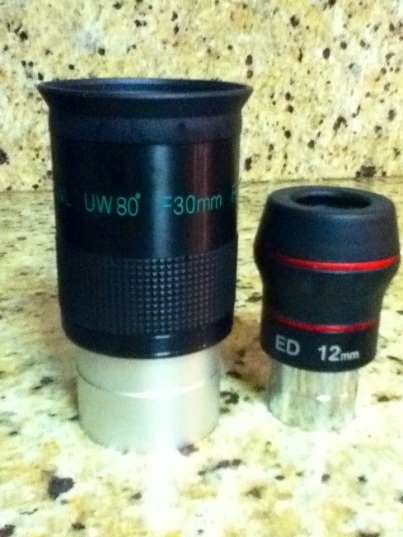I’ve recently upgraded my collection of eyepieces having some of the finest eyepiece brand names make their way into my case, Tele Vue, and Explore Scientific. I’ve been using them extensively for a month now. They have proven to be extraordinary pieces of glass, and have definitely earned a permanent spot in my collection.
On December 20th, a package arrived at the door.
And inside…
Tele Vue Nagler 16mm Type 2. This is my first and only Tele Vue eyepiece. It is the Type 2 so it’s not the most current model but that doesn’t make others better. This eyepiece has an 82 degree apparent field of view. What’s nice is that it is dual barreled, so it can be accepted with both types of focusers. Build quality is top notch, as well as optical quality. The main scope it is used in is the Meade 12.5″. It performs well as a mid power eyepiece providing 119x and a 0.68 degree true field. It’s great for zooming in on objects found with lower power eyepieces. The eyepiece has shorter eye relief than is tolerable for some, but if you don’t wear glasses its very easy to look through for anyone.
There really is something special about the Type 2 Naglers. Here is a great article regarding the history about Nagler Eyepieces. Link here. The other Type 2’s were 20mm and 12mm. The best of the type 2’s were the 20mm, but also the heaviest eyepiece Tele Vue has ever made, but all three of these are hard working eyepieces. Credit is due to someone who gave me this eyepiece, as I would not have been able to afford this, as I won it in a contest. Thanks Randy!
Here’s the other eyepiece, big in every way:
That’s an Explore Scientific 30mm 82 degree. Doesn’t look like other ES 30mm’s you’ve seen? It’s the older non water proof version, but optical quality is the same. This beast is 3 inches wide at the top and weighs in at a whopping 3.06 pounds! That caused some serious balance problems, more on that later. Why would I buy this eyepiece when I just wrote a great review for the Owl 30mm? The price one was available at was extremely low for how good this eyepiece is. After reading review after review on ES 30mm, I just had to get it. So how does it do? It’s like the 31mm Nagler, there have been many reviews directly comparing the 2, as the Nagler is the top of the line. That being said, this eyepiece is outstanding in terms of the image it puts out. That huge, expansive eyepiece is great and essential for low power viewing.
However, I have heard that the Nagler just barely edges out in terms of edge correction. The edge correction in the ES is great, the last 15% or so the stars start to slightly soften. This is in the 12.5″, at F/6. It provides very sharp views throughout and high contrast images essential for finding and observing objects. This eyepiece gave my scope several balance issues that are still being sorted out. When I put it in the focuser, the scope just dropped at every position. I had to completely change the balance and lower the counterweights, and add some ankle weights to the back of the tube. There already is a counterweight on a bar back there but it needed more. I still think I could use one more on it. The difficulty using this is that when I change eyepieces I have to remove on of the weights in the back. This is tricky because sometimes I do that, and the scope starts to move. By removing the eyepiece first seems to fix this for the most part, but at some positions it still moves around.
As nice as the Owl 30mm is the Explore Scientific really is on the next level. But, it is still a nice eyepiece and very usable. The views in the Explore Scientific are so nice that the balance issues still make it worth it for me. One thing I’ve noticed is that the Owl is not truly an 80 degree field. It’s more like 77 degrees. If you ever get the chance to pick up an ES 82, do it, you won’t be disappointed.



